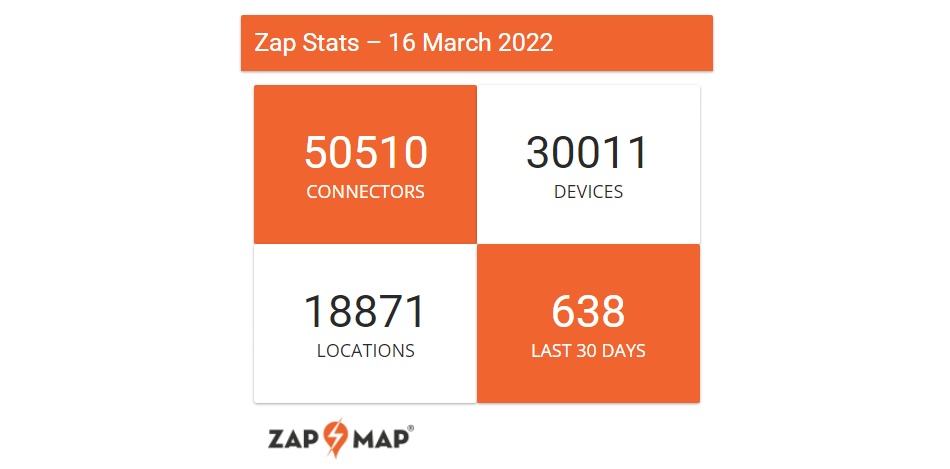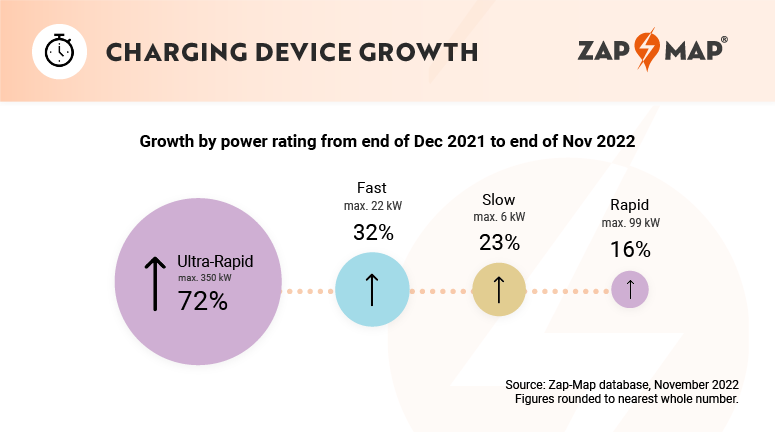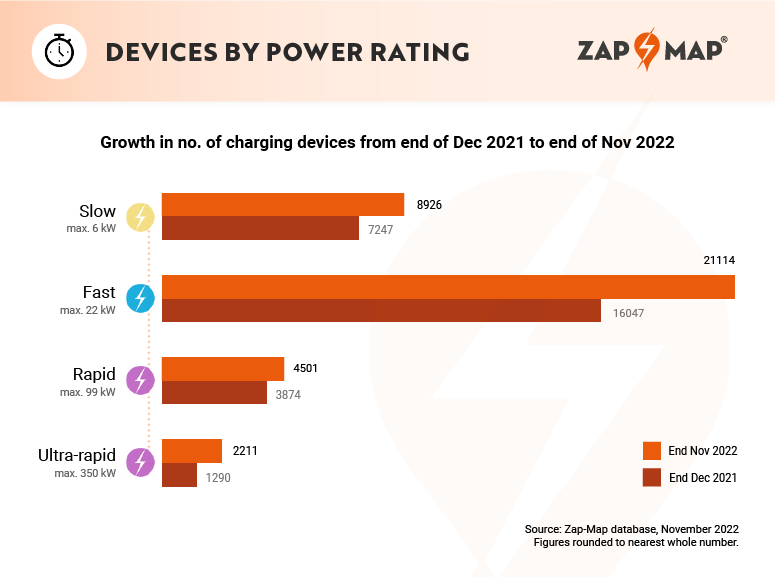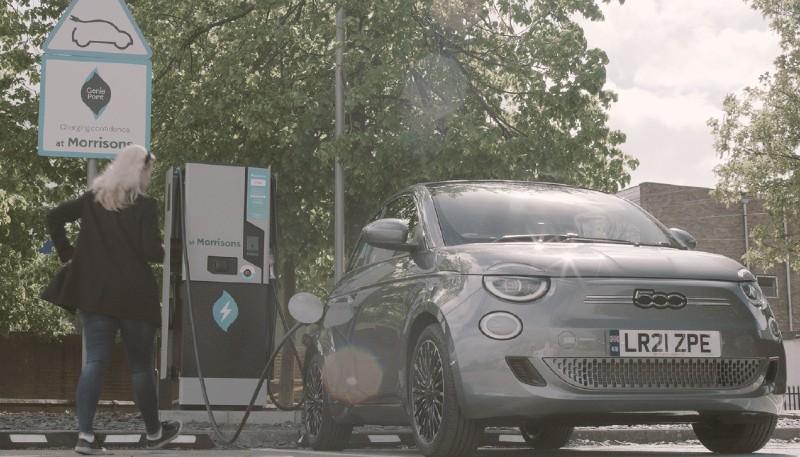Over the course of 2022, the UK’s electric vehicle (EV) charging infrastructure changed significantly. There was certainly a lot to keep track of in a booming industry.
2022 saw countless announcements made, milestones hit and partnerships forged. But most importantly, the loudest sound came from thousands of EV charging devices going into the ground.
Here we highlight just some of the key moments for EV charging in a year of change. We also take a look at some of our own predictions from last year about the EV charging landscape in 2022.
EV charging growth: How many?
As we entered 2022, the number of EV charging devices in the UK stood at almost 28,500, while just under 400,000 pure-electric cars were skimming quietly over UK roads. So what’s happened since then?
Well, on 16th March the UK surpassed 30,000 charging devices – and the Zapmap team breathed a collective sigh of relief, having predicted the UK would hit that milestone in the first quarter of the year.

The UK surpassed 30,000 charging devices on 16th March 2022.
Where are we now?
As of November, the UK now has more than 36,700 changing devices – across almost 22,000 charging locations – while over 620,000 pure-electric cars rely on this infrastructure.
While we are not quite at the end of the year, it is unlikely that we will hit our more ambitious prediction that the UK will pass the 40,000 devices mark in 2022. However, it is worth mentioning that charge point operators have experienced supply shortages from manufacturers over the course of the year due to the global supply chain issues.
Despite this, it is looking highly likely that rapid and ultra-rapid charging devices will together top 7,000 by the end of the year – another Zapmap prediction.
“In terms of the UK’s high-power charging network, which enables drivers to recharge quickly during longer journeys, these ‘en-route’ chargers are going in at a pretty good rate,” says Melanie Shufflebotham, Zapmap Co-founder & COO.
“We’ve seen this network expand at pace, largely thanks to investment from the private sector. The most significant growth has come from the speediest ‘ultra-rapid’ charging devices, predominantly found at charging hubs near major roads and motorways.”
However, as many drivers will know, it’s not simply about how many devices are going into the ground. More important still is what is going in, and where.
EV charging growth: What goes where?
“While it’s good to be aware of the number of EV chargers in the UK, it’s important for the conversation to take on a little more nuance,” says Shufflebotham.
“Why? Because over the next few years, the UK will need a mix of charging solutions to suit a wide variety of use cases. Focusing solely on the number of charging devices masks the different types of charging available, what they’re useful for, and which ones are needed where.”
So which types of chargers are being installed where?
High-power chargers
2022 has been the year that high-powered EV charging devices really came to the fore. Often found in ‘hubs’ of six devices or more, these devices are prime examples of ‘en route’ charging, when drivers want to charge their car as quickly as possible.
High-power charging hubs have been springing up across the country. Shell Recharge opened its first dedicated EV charging hub in Fulham. GRIDSERVE opened the first rapid charging hub in Wales, at Swansea Services. MFG EV Power’s Ardwick site near Manchester went live. Osprey’s flagship hub at Paisley Pear in Northamptonshire impressed many. InstaVolt opened its Thinford hub in County Durham, while a brand new Fastned charging hub went live in Scotland too. The list goes on.
If it’s stats you’re after, the number of ultra-rapid charging devices across the UK has shown a 72% increase from the end of December 2021 to the end of November 2022.
And as you may have gleaned from the list above, these types of charging hubs are predominantly found near the major roads and motorways that comprise the UK’s strategic road network. But what about other types of chargers?

Slower chargers for residential streets
2022 also saw significant growth in another key area: the provision of on-street charging infrastructure. Found on residential streets, these devices tend to be either slow or fast chargers and, generally speaking, provide an alternative to charging at home.
In the first 11 months of the year, the number of on-street chargers increased by 34%, growing from 8,842 at the end of 2021 to a total of 11,858 devices by the end of November.
As you can see in the infographic above, slow and fast devices – which predominantly comprise on-street infrastructure – have shown fairly significant growth over the course of the year, showing increases of 23% and 32% respectively.
“On-street charging provision is currently rolling out quite rapidly, but patchily. There are a few reasons for this. One of them is that each local authority has different needs, and I don’t think there’s a perfect blueprint yet,” says Shufflebotham.
“In any case, research from Field Dynamics and Zapmap this summer showed that, while there is still some way to go, on-street charging provision is improving.
“For example, the percentage of households without the space to charge at their own property – but who live within five minutes’ walk of a public charger so they can easily plug in their car and walk home – rose from 12%, in 2020, to 17%. That’s a significant overall increase, of more than 40%.”

On top of this, 2022 also showed that there is appetite for another solution, community charging, where EV drivers share their home charger with others to provide an alternative charging option for those without access to a home device.
Indeed, Zapmap’s survey found that 20% of EV drivers would be prepared to share their home device, suggesting that community charging could well play an important role in the transition to electric vehicles.
In October, Zapmap partnered with JustPark, setting its community charging network JustCharge live on Zapmap. The partnership, which aims to make EV charging simple and accessible, offers Zapmap users the ability to find and book almost 2,000 JustCharge community chargers directly through the Zapmap app.
Rapid 50kW chargers
As well as examining the chargers that are being installed, it’s also important to consider which chargers are not going into the ground at such a pace.
Some of you may remember Zapmap’s prediction last year that rapid 50kW chargers will become a thing of the past (with 100kW+ becoming the norm, while slow and fast chargers will fulfil different needs).
Well, so far this prediction certainly looks to be holding water. As you can see in the infographic above, rapid chargers showed the smallest increase (16%) of any power rating between the end of December 2021 and the end of November 2022.
EV charge point reliability: Are they working?
Charge point reliability continued to be the number one concern for EV drivers in 2022. In Zapmap’s annual EV Charging Survey, reliability was brought up as an issue by 65% of respondents. Reading some newspaper headlines in 2022, you could also be forgiven for thinking that no charge points were working at all.
However, with live data on around 70% of all UK charge points, Zapmap is able to monitor the proportion of charge points that are out of service and provide independent data on the matter.

Charge points installed since 2021 are generally performing well.
Zapmap’s data shows that across the year there were around 6% of chargers out of service at any point in time. But, when looking at chargers that have been installed since 2021, this figure fell to around 3%. This indicates that there are certainly issues with legacy chargers, but more recent installations are generally performing well.
To help EV drivers identify reliable chargers, Zapmap’s annual Charging Network Rankings highlight those networks that provide reliable, easy-to-use chargers. In addition, the Zapmap location rating and chats helps EV drivers to identify which chargers are more likely to provide a good experience.
Paying for charging: How much?!
“Looking ahead to 2022, I don’t think I’ll be alone in expecting to see hikes in pricing from charge point operators across the country, not least because of increases in wholesale energy prices,” said Alex Earl, Commercial Director at Zapmap, in December 2021.
“We’ve already seen some operators take this course of action, and I wouldn’t be surprised if others join them.”
In December 2021, our prediction was for 40p and above per kWh to become the norm for EV charging, at least for ‘en route’ hubs. While correct, this turned out to be a slight underestimation.
“We’re also likely to see prices splitting out to reflect specific charging speeds,” Earl continued. “So you’ll see one price for your ultra-rapid chargers, one for rapid, and others for fast and slow devices.” He wasn’t wrong.
Primarily as a result of restricted gas supplies and geopolitical instability, wholesale electricity prices increased dramatically in 2022, with the UK seeing a new record high peak in September. The trend pushed charge point operators’ costs higher than ever, with these increasing costs inevitably being passed on to EV drivers using public networks.

Electricity prices reached a record high in September.
To help EV drivers keep track of changing prices on the public charging network, Zapmap launched a charging Price Index and rapid pricing tracker to monitor the shifting costs of charging.
Zapmap also chose to support the FairCharge campaign, which aims to bring the VAT rate on public charging in line with the VAT rate on domestic energy, bringing down costs for EV drivers without access to a home charger. This is because differential VAT prices raise the concern that those without home chargers are being penalised in terms of charging costs.
Paying for charging: How do you pay?
With people increasingly making the switch to electric vehicles over the course of 2022, more and more drivers have been asking the questions that come with the day-to-day running of an EV. How to pay for charging is one of these new considerations.
While many EV drivers do the majority of their charging at home, others use the UK’s public charging network more frequently. In any case, most longer electric journeys also involve a stop-off at a public charge point to recharge the battery and grab a coffee.
Most, if not all, EV drivers know that there are several different ways to pay for EV charging in the UK.
In part, that was why one of our predictions from last year was that the focus of EV charging will shift to the consumer and to ease of use, with simple cross-network payment available across the majority of the key networks.
Hopefully most drivers will agree that 2022 was the year that paying for charging did actually get a bit easier, with all-in-one app solutions, such as Zap-Pay from Zapmap (and other companies too), beginning to make a tangible difference for EV drivers when out and about.
2022 certainly saw some significant steps forward for cross-network payment service Zap-Pay and the many Zapmap users who take advantage of it to pay for charging.
Over the course of the year, we welcomed four new charging providers to the live Zap-Pay partner network. First up, nationwide providers GeniePoint and Mer went live on Zap-Pay in April and July respectively. Not long after, ultra-rapid charging network MFG EV Power joined the pack too. Most recently, in December, growing provider Fastned went live on Zap-Pay.
The four new providers joined Osprey, ESB Energy and char.gy, meaning seven networks are now live on Zap-Pay, with around 4,000 charging devices across the UK currently Zap-Pay enabled.
Connected Kerb and ChargeMyStreet are next to go live with Zap-Pay in early 2023, with other networks including EB Charging, Alfa Power, evyve and Revive lined up thereafter.
We will of course be making more announcements in 2023 as more networks sign up to Zap-Pay and expect to have agreements in place with around 20 charge point operators by the end of the year, with chargers already covering the length and breadth of the country.
EV charging: Who said that?
As mentioned earlier, 2022 was a year of countless announcements. But a particularly significant one came in March, when the government unveiled plans to support the UK market in reaching 300,000 public charging points by 2030.
Among other measures, the announcement included a £450 million Local Electric Vehicle Infrastructure Fund, with the aim of boosting projects such as EV hubs and on-street charging, so those without driveways don’t miss out on cleaner transport.
In line with the government’s consumer consultation, also published in March, the plans will set out a requirement for a 99% reliability rate at rapid charge points – to give drivers confidence in finding charge points that work wherever they travel.
Another significant announcement came in October, this time from the British Standards Institution (BSI). Sponsored by the UK Government and the charity Motability, the BSI launched a new accessibility standard for EV charging, PAS 1899:2022, Electric vehicles – Accessible charging – Specification.
This announcement was a crucial step forward for disabled EV drivers – because the new standard helps procurers of public charging points ensure that the UK’s EV charging infrastructure is accessible for all users, including disabled people.

The announcement of the new accessibility standard was crucial for disabled EV drivers.
“We welcome BSI-Pas 1899-2022, the new accessibility standard, which will help charging providers in developing infrastructure fit for all users,” says Shufflebotham.
“With the UK’s public charging infrastructure growing fast, we need to ensure that electric vehicle charging is accessible to all drivers including disabled people.
“That’s exactly why Zapmap partnered with Motability Operations earlier this year to trial both the Zapmap app and the physical charging points it maps. With people increasingly making the switch to electric vehicles, it’s critical that no-one is left behind.”
Indeed, as we enter 2023 and the UK continues to transition towards a net-zero economy, it is only by ensuring that as many people as possible can make use of electric vehicles that the transition will be successful, just and inclusive.
In carrying out this review, we could only ever hope to highlight some of the key moments in EV charging during a year of huge change. A lot has been left out.
If you are interested in how EV charging will be different in 2023, see the article below, which details what the team at Zapmap thinks is coming for EV charging in the year ahead.



